Quality of dental restorations. FDI Commission Pro... - ResearchGate
Quality of dental restorations. FDI Commission Pro... - ResearchGate
Quality of dental restorations. FDI Commission Pro... - ResearchGate
Create successful ePaper yourself
Turn your PDF publications into a flip-book with our unique Google optimized e-Paper software.
124ning the material, operator andpatient effects on restoration quality.One <strong>of</strong> the major issuesappears to be the statistical treatment<strong>of</strong> data. It is difficult toconduct clinical studies, with theaim <strong>of</strong> establishing a numericalrelationship between one specificrisk factor and the technical excellence,restoration service period orreplacement reasons. The mainreason is that the clinical performance<strong>of</strong> a restoration is dependenton many known and unknownclinical variables that are difficultto control or record. It is alsodifficult, if not impossible, toassure independence among manyclinical variables that affect restorationclinical performance. Currently,there do not appear to be anygenerally acceptable, valid statisticaltechniques for isolating theinfluence <strong>of</strong> a single variable;indeed, many <strong>of</strong> the variables maynot be independent. In full knowledge<strong>of</strong> this situation, clinicalresearchers employ various strategieswhen designing trials aimingto clarify parameters <strong>of</strong> restorationquality (Figure 3).Restoration quality has beenaddressed in both prospective andretrospective longitudinal studies aswell as in cross-sectional studies.Data from prospective and retrospectivelongitudinal studies can beused for constructing survivalcurves, proportions <strong>of</strong> <strong>restorations</strong>with varying technical excellence asa function <strong>of</strong> time and reasons forreplacement.Current restorative materialshave excellent physical and mechanicalproperties. <strong>Pro</strong>spective clinicalstudies therefore need to beextended for many years and/orinclude large numbers <strong>of</strong> <strong>restorations</strong>before any strong statisticalinferences can be made. Longobservation periods are associatedwith problems such as patient dropouts,patient representativity andchanges in the clinician’s diagnosticabilities or understanding <strong>of</strong> replacementcriteria. Finally, also ethicalreasons may occasionally restrict theFigure 3. Parameters <strong>of</strong> the quality <strong>of</strong> <strong>dental</strong> <strong>restorations</strong>. The horizontal axis representstime, while the vertical axis is the proportion <strong>of</strong> <strong>restorations</strong> remaining over time. The boldline represents the proportion <strong>of</strong> <strong>restorations</strong> remaining in situ (that is ‘survival’), and theseare in the category ‘excellent’ (for example ‘alpha’), ‘acceptable’ (‘beta’) or ‘defective’(‘charlie’). Replacements may be ‘true’ reasons, that is bulk fractures, secondary caries,marginal deficiencies, discolouration, etc, or because <strong>of</strong> faulty diagnosis, inclusion intolarger <strong>restorations</strong>, primary caries on other surfaces, etc. Arbitrarily lines depict theproportion <strong>of</strong> <strong>restorations</strong>/replacements that fall into the carious categories. The horizontalline at 50% marks the median survival time. The intersections between this line and the otherlines represent from left to right when 50% <strong>of</strong> the remaining <strong>restorations</strong> are: excellent,acceptable and remaining in situ.possibility <strong>of</strong> conducting prospectiveclinical studies.Retrospective studies are basedon analysing patient records or acombination <strong>of</strong> patient records andquality evaluation <strong>of</strong> <strong>restorations</strong>.A frequent problem with manyretrospective studies is that little orno information is available onpossible reasons for replacement.Several studies have revealed thatreplacements are not alwaysexplained by restoration failure 1 ,and even if they are, retrospectivedata give no indication regardingwhether the failures are relateddirectly to the restoration, to therestorative process or to externalfactors 72 .Cross-sectional clinical studieshave either been presented asreplacement studies or recordings<strong>of</strong> data from patients’ records.Other data have been derived fromassessment <strong>of</strong> technical excellence<strong>of</strong> <strong>restorations</strong> in situ or inextracted teeth, or from detailedstudies <strong>of</strong> failed <strong>restorations</strong>.Cross-sectional studies that focuson mean age <strong>of</strong> failed <strong>restorations</strong>identify the ‘geometric centre’ <strong>of</strong>the area above the survival curve inFigure 3, while studies that focuson the age <strong>of</strong> remaining <strong>restorations</strong>identify the centre below thiscurve.In replacement studies, theprevious history and age <strong>of</strong> the<strong>restorations</strong> is <strong>of</strong>ten unknown.Although the type <strong>of</strong> materialusually is recognised, specific tradenames or batch numbers areseldom recorded. A characteristic<strong>of</strong> the study method is that theevaluation criteria are not explicit,which leaves the diagnoses to theoperators involved in the study. Theresults do not indicate any causalrelationships, and they are probablyinfluenced by factors such associoeconomy, patient demographyand the dentist:patient ratio. Thesame arguments are applicablewhen interpreting results fromcross sectional studies. Although theevaluation criteria may <strong>of</strong>ten beaccurately described, the history andclinical parameters at the time <strong>of</strong>restoration placement remainsunknown.International Dental Journal (2001) Vol. 51/No.3



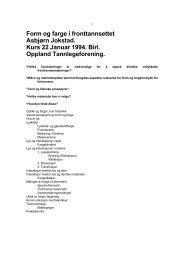
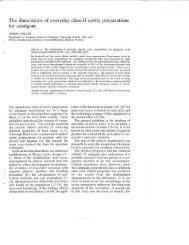
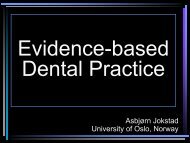
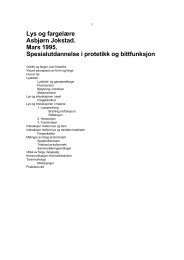

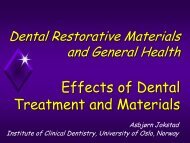
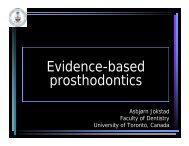

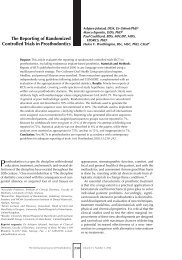
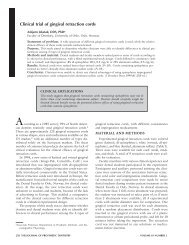

![[Sementer i fast protetikk] Scandinavian Society for Prosthetic](https://img.yumpu.com/18378889/1/190x245/sementer-i-fast-protetikk-scandinavian-society-for-prosthetic.jpg?quality=85)
